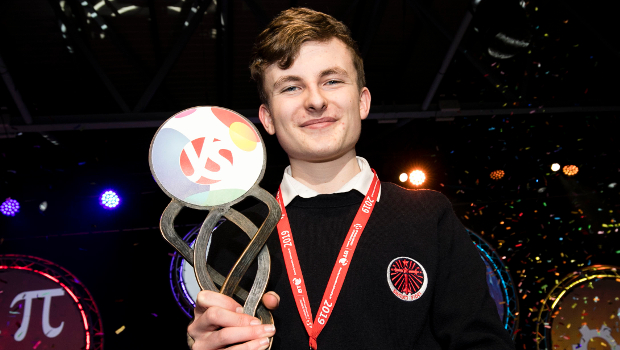
Quantum computing project takes top prize at BT Young Scientist competition
The winner of the 55th BT Young Scientist & Technology Exhibition (BTYSTE) has been announced. Adam Kelly, aged 17, a fifth year student from Skerries Community College, in Dublin, has taken home the top prize for his project entitled Optimising The Simulation Of General Quantum Circuits.
The award includes the prize of €7,500 and the BTYSTE perpetual trophy. In addition, he will represent Ireland at the European Union Contest for Young Scientists, taking place in Bulgaria in September 2019.
Speaking about the winning entry, BT Young Scientist Judge and Chair of the Chemical, Physical & Mathematics Category, Prof Sean Corish, said: “Quantum computing is an emerging technology which represents a potentially significant advance in computing.
“Adam developed a tool to select the optimum algorithm for the simulation of particular quantum circuits, which may inform the development of a practical quantum computer, which is still at an early stage. This has implications across many areas, including cybersecurity.
“In addition, he used open source code to parallelise quantum simulation on graphical processing units that is significantly quicker than other available simulators and this work has already come to the attention of key industry leaders
“Adam’s contributions are underpinned by a fluency in what is a highly technical and complex field which hugely impressed the judges.”
The award for group winner went to Aoife Morris and Tianha Williams, both aged 16 and transition year students from St Aloysius College Carrigtwohill, Cork for their project entitled Developing an organic solar cell coating solution to mitigate fossil fuels usage by motor vehicles. The students were in the chemical, physical & mathematical sciences category at Intermediate level. This project develops an organic solar cell which can be used to partially power an electric car. The students investigate and characterise different materials for use in the solar cell. Organic solar cells are thinner, more flexible and cheaper than inorganic solar cells. The use of solar cells reduces the need for fossil fuels in the automotive industry and addresses the global environment issue of pollution and climate change.
The individual runner-up award was presented to Yasmin Ryan, 16, a fifth year student at St Andrew’s College, Dublin for her project entitled ‘Discovery of the ideal microenvironment for the differentiation of hiPSCs into islets of langerhans’. Yasmin was in the Biological & Ecological category at Intermediate level. Her project concerns the generation of special cells called stem cells that can be used to generate pancreatic cells for the treatment of Type 1 Diabetes. A new number of proteins called ‘growth factors’ were studied using specialised databases and were identified as candidates that be used to allow for the production of stem cells. Her observations have profound potential implications for the long-term treatment of diabetes and cell transplantation.
The group runners-up award was presented to sixth year Danila Fedotov and Filip Caric, aged 17 and 18, respectively, from North Monastery Secondary School, Cork for their project A Wearable Device Which Assists Caretakers by Providing them with the Information on the Well-Being of Their Patients. The students were in the Technology category at senior level. This project has resulted in the development of a wearable device that monitors the location and status of elderly people with a specific focus on those living with dementia. The prototype is strapped to the upper arm and will communicate with a mobile phone app to allow caregivers to not only constantly monitor the wearers’ well-being, but also to alert in the event of a fall.
The number of project entries has almost tripled from 606 in 2000 to an impressive 1,803 in 2019, with entries submitted from across the island of Ireland. A total of 56% qualified entrants were female, with a significant increase of 62% in the number of girls qualifying in the chemical, physical, & mathematical sciences category this year. Some 10% of entries for the 2019 Exhibition are from DEIS schools, a positive indication of the power of this platform to engage participation in the critical STEM subjects.
TechCentral Reporters







Subscribers 0
Fans 0
Followers 0
Followers